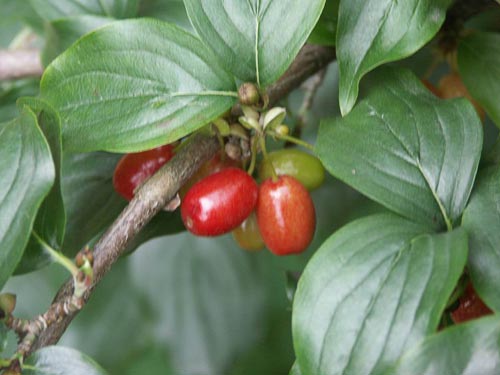Relatives
Cornus mas L. - Cornelian cherry male or common.
Taxonomic position.
Family: Cornaceae Dumort.; genus: Cornus L.Morphology and biology.
Perennial plant; bush or a low tree that is 2-5 (9) m tall. The trunk is up to 25 (45) cm in diameter, with very firm wood and a bark of grey color with appreciable cracks. Young shoots have a green color, are covered by appressed hairs; annuals and older ones are yellowish-grey up to reddish-brown. Leaves have short, 5-10 mm long, petioles, covered with appressed bristly hairs. Leaves up to 11 cm in long and 5 cm wide, have various forms, from ovate or ovate-elliptic up to lanceolate and narrowly elliptic, with a sharp top and round base. Flowering occurs before leafing. Flower-bearing shoots are 5-8 mm long. Leaflets of a wrapper are ovate, suddenly coming into short edge at their ends, yellowish-green, 5-10 mm long, 3-6 mm wide, outside are dense pubescent. The inflorescence consists of 15-20 flowers, dense pubescent pedicels that are 4-9 mm long. Ovary is dense, appressed and hairy, about 1 mm long. Denticles of calyx are triangular; petals are lanceolate-triangular, 2-2.5 mm long, after flowering turned back down. Stamens are 2 times shorter than petals. Matured fruits are red, sometimes pink; elliptic, cylindrical or expanded in upper part; from 10 up to 20 (30) mm long; smooth or slightly acies, the taste is sweetish or sour. Stone form is elliptic or spindle-shaped, almost smooth. Entomophilous. Zoochore.Distribution.
Occurs in the southern part of Middle Europe; south-eastern part of Atlantic Europe, Mediterranean (middle part of Italy), Balcans, Asia Minor. Within the ex-USSR territory: Upper Dnestr, Moldova, Crimea; all Caucasus.Ecology.
Grows among mountain woods of the lower and middle belt, in the Caucasus it reaches up to 1500 m above sea level. It grows in underbrush of light woods, mainly oak and hornbeam, on marges, on slopes, in thickets of bushes.Utilization and economic value.
Fruits, rich in vitamins, acids (especially - apple acid) and sugars, are used as fresh fruits for preparation of jam, compote, kissel, fruit candy, drinks and wine. Fruits, stones and leaves are used for medical purposes as a fixing means. Firm and strong wood is well polished and used for turning works, replacing boxwood. The bark, branches and leaves contain tannins of high quality and are used for the tanning of thick leather and its coloring in yellow colors. Good honey plant. As an ornamental plant it is used for green hedges. Decorative forms have the different form of a crown (pyramidal, spherical), and different form and coloring of leaves (yellow leaves, variegated leaves, wavy leaves, etc.) and various forms and coloring of fruits (yellow, yellowish-white, pink).Reference citations:
Cherepanov S.K. 1995. Plantae Vasculares Rossicae et Civitatum Collimitanearum (in limics USSR olim)[List of Vascular Plants of Russia]. St. Petersburg: Mir I Semia. 990 pp. (In Russian)Grossgeim, A.A. 1967. Flora of the Caucasus. V. 7. Leningrad: Publishing House of the USSR Academy of Sciences. 151 p. (In Russian)
Mosel H. 1965. Comparative Chorology of the Flora of Central Europe. Jena. 583 p.
Shishkin, B.K., ed. 1951. Flora USSR. V. 17. Moscow-Leningrad: Publishing House of Acad. Science. 317-319 pp. (In Russian)
Sokolov S.I., Svjaseva O.A., Kubli V.A. 1986. Areas of distribution of trees and shrubs in the USSR. V. 3. Leningrad: Nauka. Map #53D. (In Russian)
Vulf E.V., Maleyeva O.F. 1969. Worldwide resources of useful plants. Reference book. Leningrad: Nauka. 338-339 pp. (In Russian)


